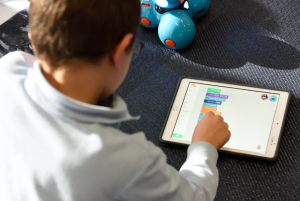Remote learning, just like remote working, might be the new normal for at least a while.
Edtech has been garnering considerable attention and the industry is estimated to cross USD 2.7 billion by the year 2035. The COVID-19 pandemic has resulted in conventional educational organizations embracing Edtech, digital learning, and remote education more than ever before and this trend is expected to continue post-pandemic. Schools across the world shut and more than 1.2 billion students in more than 186 affected countries are confined to home due to the lockdowns. While some countries are now opening up schools gradually, the fear among the parents persists, pushing students to continue remote learning for the upcoming academic year.
Remote Learning and Parents
But it is not easy, especially for the parents. While not having a morning school routine might have seemed to relieve initially, the sheer responsibility of making the kids sit through online classes, especially in today’s era of short attention spans, is tough. Parents have to juggle between their home offices while ensuring that the kids attend online classes, complete assignments, and are also entertained throughout the day with a plethora of activities.
Working or not, parents have the added responsibility of now educating their kids and this has become a burden for the parents in ways more than one. Schools, educators, and educational organizations can step in and help out the parents to make remote learning burden-free. And this can be achieved with the help of the right set of technology and tools.
How to Make Remote Learning Burden-Free for Parents
- Provide relevant hardware
While having dedicated tablets or computers for kids is more rampant than ever, there’s a large digital divide in the availability of devices for students. In several families, there is only one computer/laptop that is shared between the family and often, the same computer doubles up as a remote working device for the parent. In order to ensure that students are not deprived of learning due to the lack of technology, schools can offer student devices such as iPads, tablets, or Windows 10 laptops. These devices can be procured and owned by the school and handed over to the students for the designated use. If the schools do not want to invest large capital in procuring the devices, they can opt for device leasing which enables them to procure the device at lower costs and update the tech whenever needed.
Along with the devices, schools can also extend mobile hotspot devices to enable students to connect to the internet without depending on the availability of Wi-Fi in the home. This levies the burdens of device financing for the parents.

- Couple it with the right software
Offering students with devices for remote learning is, of course, not enough. The schools can couple the hardware with necessary remote learning software, e-learning apps, and educational resources that the students can rapidly access. A tool for restricted and secure communication on these devices can further ensure that parents can quickly get in touch with the educators, school staff as well as their peers to resolve queries, help with group assignments and more.
- Ensure to keep it distraction-free
Technology when unmonitored is a double-edged sword. The student devices need to be made distraction-free meaning that entertainment apps should be blocked and so shall social media. Blocking access to websites that are non-educational can further help in ensuring that the students do not fall prey to cyberbullying or attacks.
Parents can rest assured that when the students are attending online classes and using the device throughout the day for home assignments, they have nothing to worry about! An MDM tool for education can be incremental in making the devices ready for remote learning without hampering the students’ experience while using the device.
- But add options for engagement
After a few hours of online classes and assignments, the kids are restless to do more. While on an ordinary day they could probably go out, play outdoors or meet their friends, in the lockdowns or the era of social distancing, this is slightly difficult. Parents have to find innovative ways to keep the kids engaged and here’s how schools can make it burden-free.
The school devices can also offer a couple of non-educational yet fun, safe for the respective ages and interesting online activities, games, puzzles or quizzes. Parents can focus on their work while the kids engage in learning but of a different kind.
- Offer remote support for device troubleshooting
When the student device hardware or software fails, students not only miss the classes but the parents also have to spend additional time and effort in troubleshooting the issues and looking for fixes. Sometimes the apps won’t start, sometimes the access to an online meeting is not authenticated, and more often than not the parents do not know what to do next.
To ensure consistency in remote learning, schools can offer remote device troubleshooting. The school IT teams should periodically check for device health, automate alerts for any security, usage, or compliance issues and offer quick remote troubleshooting and fixes over the air.
Summary
Remote learning, just like remote working, might be the new normal for at least a while. Even when the schools open up eventually, they might allow only partial class strength to maintain social distancing and kids might have to visit the school on alternate days. The future is unpredictable but with the right help from schools and co-operation from parents, remote learning can become an affirmative step towards modern learning.


Join the conversation!